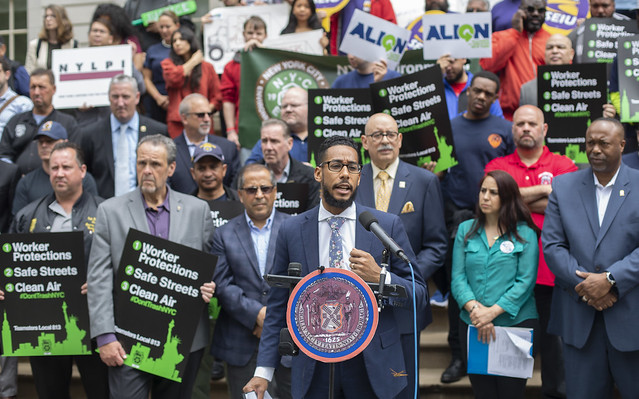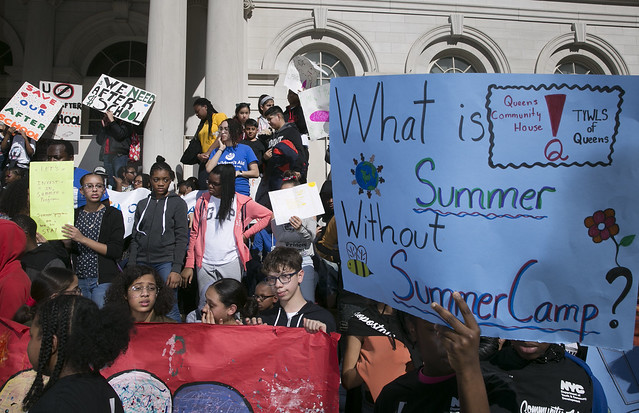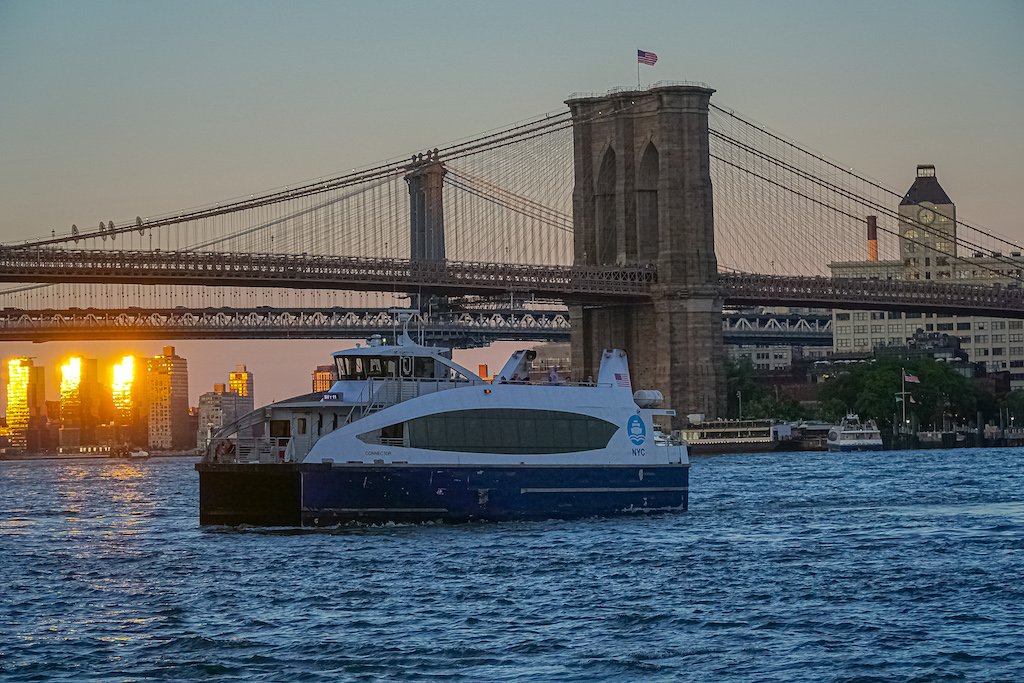After Rightly Declaring Climate Crisis, the Next Important Step for the City Council

Council Member Reynoso (photo: John McCarten/City Council)
It is heartening that the New York City Council recently voted unanimously to declare a state of climate crisis. 2019 has already brought a string of droughts, record-breaking heat waves, crop failures, and storms, and it is obvious that this is the challenge of our lifetimes.
Having declared an emergency, now comes the time for swift additional action. After state and city lawmakers passed mandatory building retrofits, congestion pricing, and statewide emissions reductions, the next major climate bill our local government must pass is the Commercial Waste Zone Bill (Intro. 1574 before the City Council).
What does garbage from New York City’s more than 100,000 businesses have to do with global warming?
Our office buildings, pizzerias, hospitals, and grocery stores send about 2.2 million tons of waste per year to landfills and incinerators, where it slowly decomposes and produces methane, a climate pollutant 28 times more potent than carbon dioxide.
When it comes to basic recycling and composting of waste, New York’s business sector lags far behind cities like Seattle and San Francisco, which currently diverts 65% or more of their commercial waste. We simply will not meet our climate goals if we do not tackle our wasteful sanitation industry.
Second, the 90 or so private companies that collect New York City’s commercial waste exist in a highly dysfunctional “Wild West” system in which they operate inefficient truck routes, cut corners on recycling, and pressure workers to complete dangerous and grueling shifts, as the owners attempt to compete for customers and ensure profits. Exhaustive studies commissioned by the City have found that this scheme results in 18 million unnecessary truck miles per year -- enough to drive to the moon and back 37 times.
But, less tangibly, it also means that investments in better recycling facilities, customer education, and waste reduction initiatives such as food rescue are a low or nonexistent priority for the city’s private waste industry.
The City Council can enact a common-sense, proven solution to this decades-old mess. The commercial waste zones bill (Intro. 1574) sponsored by Brooklyn Council Member Antonio Reynoso will make this system far more rational and safe by selecting a single, high-performing waste company for each commercial zone.
After selecting 20 or so providers through a competitive bidding process, the City can hold these haulers accountable to high customer service, environmental, and safety standards through comprehensive, enforceable contracts.
With the right incentives to make investments and adopt industry best practices, the new system can rapidly achieve the same recycling and composting rates as successful west coast cities -- which would prevent a whopping 2 million tons of greenhouse gas pollutants each year by reducing the huge amount of business waste trucked to landfills. That is equivalent to removing one in five cars from New York City streets.
Moreover, we would create hundreds of new, green jobs in and near our city as recycling and composting facilities employ far more workers than do transfer stations, landfills, and incinerators.
Moving the needle on climate emissions is a daunting challenge that will require action in every sector of our economy. The good news is that we don’t need to wait for further studies or new technologies to change our highly polluting private waste system.
Dozens of other cities have adopted similar zoned or franchised commercial waste systems, and many have rapidly increased their recycling rates while maintaining excellent customer service and fair prices for their business communities.
It would be a huge lost opportunity if the fear-mongering by a few well-financed business interests were to delay the passage of this common-sense, historic reform. We applaud the Council for naming climate change as a crisis, and call on Council members to pass the Commercial Waste Zone bill this summer.
***
Justin Wood is Director of Organizing and Strategic Research at New York Lawyers for the Public Interest. On Twitter @NYLPI.
***
Have an op-ed idea or submission for Gotham Gazette? Email This email address is being protected from spambots. You need JavaScript enabled to view it.
The Mayor Must Stop Leaving Summer Camp Providers and Parents Scrambling

(photo: William Alatriste/City Council)
Yasmin Schwartz is the Assistant Division Director for Middle School Programs at Cypress Hills Local Development Corporation (CHLDC), a settlement house in Brooklyn. Starting this week, CHLDC expected to run a School’s Out NYC (SONYC) summer camp five days per week for more than 100 middle school students.
Summer camp activities require careful planning and program directors must hire and vet staff through both New York City and State background checks, register students, and secure appropriate space for programs. However, Yasmin and her team were only able to officially start these lengthy processes on June 21, after the city finally agreed to fund summer camps and the Department of Youth & Community Development was able to announce contracts.
This year, like most, Mayor Bill de Blasio refused to provide funding in his budget plans for summer camp for 34,000 middle school students and summer camp providers had to endure a “budget dance” and wait for the City Council to step in and restore the money at the last minute. Enough is enough – the mayor must permanently fund summer camp for our middle school students, ensuring an end to the uncertainty and more stability for adults and children alike.
Summer camp programs provide safe recreation and education for New York City youth. Research shows that these programs help close the achievement gap, prevent summer learning loss, and keep children safe while parents work. Summer camp provides benefits for thousands of children, but access to programs is particularly important for low-income families, who may be unable to afford the cost of other summer programs.
On top of providing continued learning and stability for working families, summer camp also offers nutritious and reliable meals. In fact, 64 percent of parents of children in summer camps rely on these programs for free, healthy meals for their children.
When the mayor eliminates funding for summer camp, he isn’t just hurting children and their families, he’s doing a disservice to program directors and staff at settlement houses and other community-based organizations across New York City.
Due to Mayor de Blasio eliminating this funding from his budget, program directors like Yasmin are left waiting for budget negotiations to conclude before planning their programs. Summer camp providers must then scramble to organize their programs for middle-schoolers. For Yasmin and her team, last-minute decisions and reduced funding means late planning, fewer summer camp slots, reduced paid staff, and starting programs a week later than CHLDC typically starts camp.
This year, CHLDC was prepared to offer 414 middle school youth spots in its SONYC summer camp programs, but now can only offer 150. Yasmin and her team also had to cut their staff from 40 to 12 and notify some parents in their community that they don’t have room for their children to attend summer camp with CHLDC this summer.
These challenges don’t just impact summer camp, they put unnecessary strain on staff and community relationships that inform year-round programming. Not to mention, in the lead up to the launch of summer camp, program directors, staff, and families had to once again head to City Hall to protest and convince the mayor to do the right thing and fund summer camp programs for middle school students. Without the City Council restoration, summer camp programs for middle-schoolers may not have received funding at all.
It is time for the mayor to make 2019 the last year without baselined funding for summer camp.
***
Susan Stamler is the executive director of United Neighborhood Houses, a policy and social change organization representing 42 neighborhood settlement houses. On Twitter @UNHNY.
***
Have an op-ed idea or submission for Gotham Gazette? Email This email address is being protected from spambots. You need JavaScript enabled to view it.
Connecting Astoria and the Upper East Side: A No-Brainer for NYC Ferry

(photo: @NYCferry)
Thanks to New York City’s investment in a brand-new citywide ferry network, waterfront communities are flourishing with shorter and smoother commutes and a wave of economic activity.
Serving close to 10 million riders since launching in May 2017, NYC Ferry has almost single-handedly opened the Astoria neighborhood to the rest of New York City, doubling the annual attendance at many of our attractions and cultural institutions like Socrates Sculpture Park and the Welling Court Mural Project, providing Queens residents with reliable and efficient ferry service across the City’s waterways.
One of the most attractive aspects of a ferry service, unlike other large transportation infrastructure projects, is its ability to be nimble. The routes can be adjusted to accommodate a changing workforce and development landscape. The more connections, the better, as access to transit options improves overall quality of life, which is why we hope the city will throw a ferry life line directly from Astoria to the Upper East Side.
A distance equivalent to three, short city blocks lies between the Astoria landing in Halletts Cove and the East 90th Street landing across the East River on the Upper East Side of Manhattan, but currently no direct NYC Ferry connection exists. Both sides of the river have advocated for a ferry connection, which is an easy fix, as the infrastructure exists at both landings.
This has been brought to the attention of the New York City Economic Development Corporation (EDC), which is not planning to consider new, additional routes until 2021. However, this isn’t a new route. It’s merely a new logical and necessary connection.
EDC should recognize that with a simple green light, millions of New Yorkers will have a less than five-minute connection between Astoria and the Upper East Side, saving in excess of a 45-minute headache-inducing, subway-plus-bus commute. The connection would reduce the number of cars sitting in traffic on local streets, as well as enable easy access to the heralded Second Avenue Subway, allowing businesses to prosper, and spur additional growth.
Connecting the two sides of the river would bring about cultural and employment benefits, including easier access to work opportunities, particularly at the East Side hospitals and educational institutions, and will enhance recreational opportunities for people throughout the boroughs. A connection to the Upper East Side would also be welcomed with fanfare from the locals of Roosevelt Island and the growing tech community at Cornell.
We urge the City to approve the connection so New Yorkers can hop on board and enjoy smooth sailing, short commutes, and maximize the benefits for our residents and communities. It only makes sense to bridge the boroughs, which will quicken travel time and lessen traffic, leading to a happier and healthier New York City.
***
Tom Grech, President & Chief Executive Officer, Queens Chamber of Commerce. On Twitter @tomgrech.
***
Have an op-ed idea or submission for Gotham Gazette? Email This email address is being protected from spambots. You need JavaScript enabled to view it.




